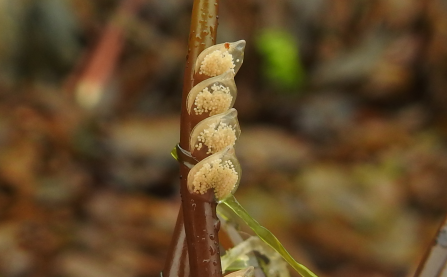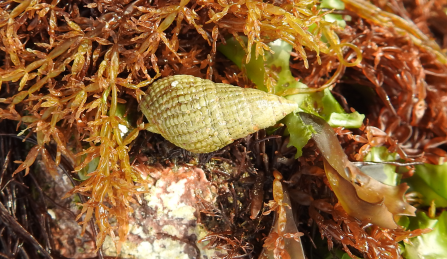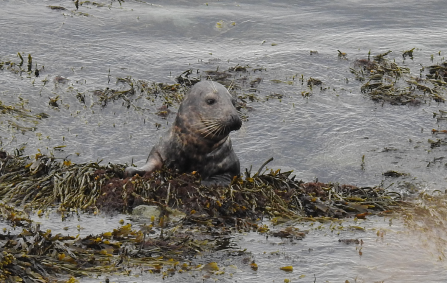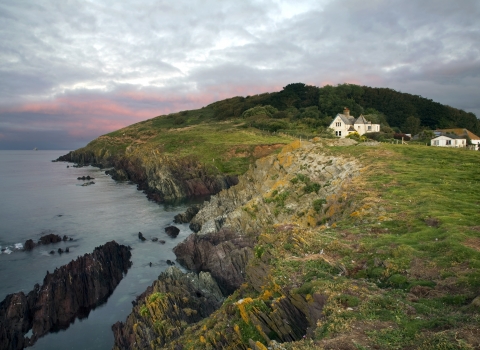You know when you are in the shower and you look up and see an oystercatcher’s bum? Really, no? Well believe me it can happen! How? In the roof over the island’s shower there is a skylight. I heard a noise above me and there it was – a white feathery bum, some fleshy coloured feet and an reddy-orange bill. All very strange but it made me smile.
Oystercatcher by Claire Lewis
The teeny weeny stuff
What’s small and stripy and can leap over 14 times its own body length?
A tiny Jumping Zebra Spider of course.

Jumping Zebra Spider
They are only about 8mm so they aren’t always obvious but we’ve been seeing these black and white cuties hanging out on sunny walls. When they do move they look funny as they seem all twitchy with stop start jerky movements. But small insects shouldn’t be fooled; theses spiders are hanging out with a purpose: hunting.
Instead of making webs to trap prey these zebra spiders jump on ‘their dinner’. As soon as they land they give a venomous bite and with that the meal is ready prepared. Apparently they can leap up to 10cm, which, let’s face, is a mighty jump for a tiny spider. These spiders have ‘good’ vison too – using 4 pairs (yes that’s 8 eyes!) to help them find prey and judge how far to pounce. Oh and I shouldn’t forget to mention that jumping zebra spiders are safety conscious. How? Well, just before it jumps, it releases safety line of silk thread which it can use to help break any falls. What a very sensible spider.
This week I found one of my favourite moths. It’s not large or colourful but it’s classy in it’s pale gold ‘cloak’.
Buff Ermine moth by Claire Lewis
See what I mean? Unsurprisingly it’s called a Buff Ermine moth, ermine being the name given to a stoat’s coat when it turns pale in the winter.
These moths are quite common and their caterpillars feed on docks, dandelions and nettles – so no shortage of their food here. As they feed up the caterpillars get too fat for their skins so they moult. With each moult they get hairier and hairier and I get warier and warier. It’s because sometimes the hairs of a hairy caterpillar can cause itchiness and skin irritation but the real danger is for predators. Hairiness is a defence – eat one of these and the predator will die. Harsh but effective, eh?
The greeny stuff
The edges of the woods and paths are turning pink – pink with blooms of Red Campion. I know, I know, the name is misleading – trust me it definitely has pink flowers!
Red Campion by Claire Lewis
I know it sounds a bit gross, but apparently this flower produces a kind of white froth, a bit like saliva. The froth helps to collect pollen off visiting insects – crafty eh? Something more charming is that the flower has lots of local names. Here’s just a few: Adder Flower, Robin Hood, Scalded Apples - but my favourite is Batchelors’ Buttons as young unmarried men were said to wear the flower as a buttonhole.
Wild Celery by Claire Lewis
Elsewhere there are white flowers of Wild Celery. I love these robust, architectural plants. The delicate spray of small flowers are held on what look like the spokes of an umbrella. The ‘umbel’ makes an excellent landing pad for insects, so it’s a top wildlife plant. If crushed the plant has a very pungent smell and although stems are strongly ridged like cultivated celery they are powerfully tangy so not recommended for eating!
The feathery stuff
When you read the word Caspian what do you think of? The Caspian Sea (which can be argued is actually a lake)? Prince Caspian from the Chronicles of Narnia? A Caspian Gull? A what? Yes, a Caspian Gull. I’d never heard of one either…. until I spotted an odd looking Herring Gull on the beach.
Is it a Caspian Gull by Claire Lewis
I’m not sure I can say exactly what was odd but there was just something that made it look different to the other gulls. So, click, click, click of the camera and photos were sent to local gull specialist, Bruce Taggart. Bruce co-ordinates the island’s ringing project of Great Black-Backed Gulls so I thought he’d be a good place to start. Agreeing that the gull looked a bit unusual Bruce shared my photos with the County Bird Recorder, Dave Parker and….. as I type I’m waiting to hear the official verdict. Will it be a new bird for the island? I know it sounds geeky but it’s all very exciting!
Now, I mentioned Oystercatchers at the start of this weeks’ blog and as I have a soft spot for them I’ve been really looking forward to talking more about them.
Look, aren’t they fab?
Oystercatcher from by Claire Lewis
Oystercatchers are what I call ‘good value birds’. They are bold and bright, they are noisy, they are active and they are very entertaining but the best bit is that they breed here on the island. This year there seems to have been a lot more fussing than usual as they pair up for nesting. You see they can be territorial and, like a flock of hens and have a pecking order. There’s an almost constant loud high pitched piping – all this fuss as means it’s breeding time!
Oystercatchers lined up on rocks by Claire Lewis
Each year we have to carefully look out for their well camouflaged nests. Well, I say nests but really they are usually just simple unlined scrapes in the ground, typically with 2-3 ‘ground coloured’ eggs. Every year there’s at least one pair that inconveniently chose to make a nest on a path. This nest is sensibly tucked up against the wall but as you can see, it’s not an elaborate structure!
Oystercatcher nest by Claire Lewis
It’ll be the female bird who’ll do most of the incubation. After about 26 days the chicks hatch out and the ‘arrival’ dates of some nests are already pencilled in our diary. Can’t wait!
The salty stuff
Sometimes after a storm we get a massive dump of ripped up seaweed thrown on the beach. This week I was walking over just such a mass when I spotted something odd stuck to the side of a piece of seaweed. It was a handful of exquisite transparent capsules containing lots of tiny cream coloured eggs. They looked wonderful but I didn’t have a clue who’d laid them.

Netted Dog Whelk Eggs by Claire Lewis
Time to call out for ID help. This time the first person to respond was Cornwall Wildlife Trust’s very own Marine Awareness Officer, Matt Slater. Matt is amazing. He just knows so much about all things marine-y. And my eggs? They belong to a Netted Dog Whelk. If you look you’ll see that these sweet looking snails have lots of criss-crossing ridges creating a netted pattern on their shell - making it easy to remember their name!

Netted Dog Whelk by Claire Lewis
What about the seals? Well once again we’ve had a seal haul itself out of the water in an unusual place. This time it was on ‘the front’ of the island. But where’s ‘the front’ on an island? We call the front the northern side as it faces the mainland.

Grey Seal Hauling out by Claire Lewis
This seal had a good old explore of the rocks and main beach. It kept thinking about hauling out in different places and then changing its mind. It made me think of Goldilocks and The Three Bears as it looked for the perfect haul out spot. Anyway I didn’t recognise the seal’s fur patterns, so it’ll be another individual for the wonderful Looe Seal Hub to investigate.
Moving to the ‘back’ of the island there was another seal - one that that I did recognise. It was the gorgeous Brittany. Earlier in the week we’d had wet and windy weather but on this occasion it was still and dry and the sea water was crystal clear. Such conditions make seal watching even more special. Why? Under the surface you can see the beautiful fur marking on the rest of their body and of course, the ease with which they use their fins to move through the water. What a lovely treat.
Brittany in clear water by Claire Lewis
Coming soon…
Surely soon we need to talk about:
- Great Black-backed Gulls,
- Sea pinks
- Bumbling beetles
Evening sky over Jetty Beach by Claire Lewis

